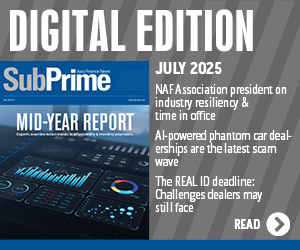Strategies for Successful Vendor Management for Auto Lenders Amid CFPB Oversight
BROOKFIELD, Wis. — Fiserv's Craig Carrow has a list of five
keys to successful remarketing, four of which deal with topics like lower turn
time, increased returns, lower operational costs and streamlined operational
processing — all of which are fairly timeless in terms of their importance.
But this fifth one has picked up steam of late, given the
Consumer Financial Protection Bureau's enhanced focus on auto lenders. With
this in mind, Carrow explained to sister publication Auto Remarketing why this
key area — vendor management — has become "the hottest topic" in the
remarketing business and how financial institutions should adapt.
"With a lot of the CFPB requirements that are coming out,
particularly around the audits that they're going to do with the banks, vendor
management is the hottest topic going right now in the industry," said Carrow,
Fiserv's vice president of automotive solutions
Carrow's company does a great deal of remarketing with banks
and other clients, in addition to servicing outside of remarketing. And much of
what Fiserv works on with the auctions ties back into what the CFPB will be
examining when it comes to auto lenders' vendor management programs, Carrow
said.
When it comes to the CFPB and vendor management, here's the
bottom line Carrow gave for any auto lender that outsources any type of
function (in this case, the vehicle remarketing that lenders conduct via
auctions):
When the CFPB comes it to conduct an audit, it is going to
examine – in addition to everything else it monitors – how you manage your
outsourced third parties.
"And they're really
looking for, in many different ways, a lot of formal documentation, he said.
"It starts literally from what the contract is that you have with your
vendors."
And by vendors, in this case, he means auctions or
remarketing partners.
The bureau, Carrow explained, wants to have an understanding
of your contract with these vendors.
"Have you set forth with (the auctions) what your
expectations are, and your service levels that are required? Then after that,
do you monitor those service levels? So, do you understand and have reports to
measure how they're performing?" he asked, giving examples of what the CFPB
might be looking for.
"And based on the variances, do you have discussions on the
topics of how they're performing and what they can do to improve, or what the
steps are going to be (for improvement)?" Carrow continued. "That whole process
sounds fairly simple, but there are also a lot of procedures where they're
looking for documentation. Like, how do you monitor them? How do you inform
them of what your expectations are? What is the process, if they're missing
your expectations, on how you look for corrective action?"
Fiserv has a program that's been out for about 15 years,
Carrow said. Any time it works with an auction, the company has a "start-up
guide" of sorts in which it explains to the auction what Fiserv's expectations
are and how it will measure the auction's performance. Fiserv also conducts
face-to-face meetings at the auction to explain what it's looking for, and has
regular monthly reports/scorecards to see how they're performing internally and
compared to the competition.
"One of the things that is very important, as far as trying
to meet some of the guidelines, is that almost every company industry will have
regularly scheduled meetings to decide what auction partners they want to use,
" he noted.
Something that Fiserv recently implemented was to publish
the meeting minutes (which they had actually been taking on a regular basis).
This is valuable, Carrow said, in the sense that ,"if the
CFPB does come out and they do an audit, you can turn around and you can give
them the full scale (of information): ‘here's what we're looking for from the
contract side; here's what we're looking at for expectations to start out;
here's how we're going to measure (the auctions). We're going to do regularly
scheduled site visits to go through and do audits. We're going to publish the
results back to you; we're going to give you your scorecard grading.'
"And then all the internal meetings are handled with meeting
minutes in a much more formal status than it ever used to be," he continued.
"Those are all kept on regular records so that if an audit does come up, we can
turn around and produce those right away, and show that the vendor management
program is in place and it's covered A to Z."
He added that the challenge with a lot of the CFPB
requirements is that the bureau explains the vendor management expectations on
a "very high level." But Carrow said Fiserv's method has proven to be an
effective approach to documentation and providing information to the CFPB.
It boils down to this: it's one thing to explain your
expectations and all the aforementioned metrics to vendors, but you've also got
to keep record of it.
In other words: "Everybody does it. But is it documented? If
you have a government regulator or auditor coming in, can you prove you did
that? I think that, by far, is the No. 1 piece. "
Another recommendation Carrow had for lenders is to "keep it
organized."
The documentation of your vendor management program needs to
be more akin to a formal presentation. It needs to be ready for audit, rather
than "bits and pieces" scattered through emails, filing cabinets and such.
The importance of being organized and audit-ready applies to
any other industry, not just the scope of the CFPB, Carrow said. When an audit
asks for your vendor management program and you have a professionally formatted
program readily at hand, it makes a great impression, he said.
"That first impression is everything," Carrow said. "The
formality of having it all centralized is very useful."
Continue the conversation with SubPrime Auto Finance News on LinkedIn and Twitter.
Normal
0
false
false
false
EN-US
X-NONE
X-NONE
/* Style Definitions */
table.MsoNormalTable
{mso-style-name:”Table Normal”;
mso-tstyle-rowband-size:0;
mso-tstyle-colband-size:0;
mso-style-noshow:yes;
mso-style-priority:99;
mso-style-qformat:yes;
mso-style-parent:””;
mso-padding-alt:0in 5.4pt 0in 5.4pt;
mso-para-margin-top:0in;
mso-para-margin-right:0in;
mso-para-margin-bottom:10.0pt;
mso-para-margin-left:0in;
line-height:115%;
mso-pagination:widow-orphan;
font-size:11.0pt;
font-family:”Calibri”,”sans-serif”;
mso-ascii-font-family:Calibri;
mso-ascii-theme-font:minor-latin;
mso-fareast-font-family:”Times New Roman”;
mso-fareast-theme-font:minor-fareast;
mso-hansi-font-family:Calibri;
mso-hansi-theme-font:minor-latin;}


